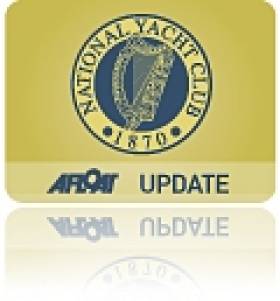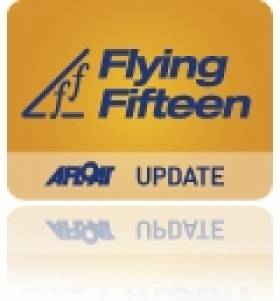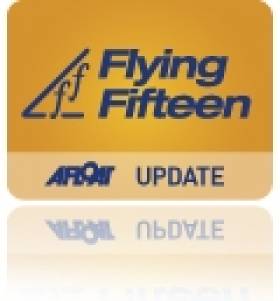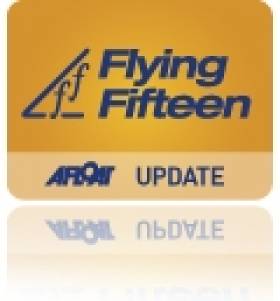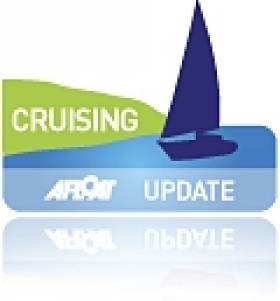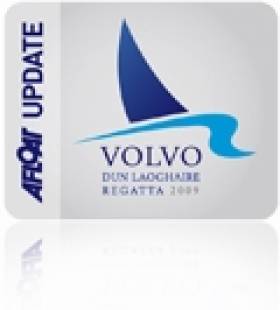Displaying items by tag: National YC
#NYC – Howth visitor Darragh Sheridan sailing 'Dinghy Supplies' was a clear winner of the SB20 sportsboat division with two wins in Saturday's National Yacht Club Regatta. ALL CLASSES RESULTS DOWMLOADABLE BELOW.
Fifteen gusting to 25–knot south–westerlies ensured few complaints from any of the sailors with a full programme of races for 20 cruiser, keelboat and dinghy classes.
Sheridan topped a 13-boat fleet with Royal St. George boats taking second and third. Barry O'Neill's Sin Bin was second and David Barry and John O'Driscoll shared third, both on 11 points.
In the Dragon class there was a similar result when Royal St. George boats shared the top prizes. David Williams sailing Phantom beat Edinburgh Cup winner Martin Byrne for regatta honours. In a seven boat fleet there was a three way ties for tie for third place between Denis Bergin, Michael Doorly and Michael Halpenny all on eight points.
NYC regatta results available to download as word docs below.
Sharkbait Wins National Yacht Club's SB20 Eastern Champs
#SB20 – Howth Yacht Club's Sharkbait Ben Duncan (3287) sailing with Brian Moran and Paul Adamson won the first of the 2012 SB20 sportsboat championships with three wins in a series cut short by strong winds at the National Yacht Club in Dun Laoghaire today.
Second in the 28-boat fleet was Aidan O'Connell (3072) Graham Elmes and Brian Reilly and third Rob Howe (3338) with Paul McDonland and Ross McDonald, the latter two fighting it out for second but O'Connell winning out on countback.
Full results downloadable in PDF format below.
Green and Doorly lead Flying Fifteen Frostbite Series
There are over thirty boats entered with over 20 of them Flying Fifteens, quiet an impressive turnout leading some to conclude that maybe we should be sailing more in the winter when there are less distractions!
After four races and one discard Green/Doorly lead the way along with McCambridge/Murphy with Poole/Marsden in third place. There have been plenty of thrills and spills and PRO Ian Mathews and his team have had their work cut out to keep things running smoothly but smooth it has been with excellent courses and racing.
The first week was cancelled due to light winds and on week 2 we just got one race in between squalls of 30 plus knots! This became survival and the PRO took the sensible and correct options of cancelling the remaining races. In Race 1 the lead changed a few times with Crummy Burgess leading at the final weather mark but hit it allowing Green to nip in and take the gun on a shortened course. Dooley/Hickey were second with McCambridge/Murphy third. Some of the crews had plenty of practice bailing out but all survived!
Race 2 took place on Sunday on a sunny day in a nice force 3 in west/south west shifty winds with the tide coming in. The fleet were a bit over eager and eventually after a couple of general recalls the black flag came out, this still didn't stop a number of boats including Crummy, Dumpleton, Sherry and O'Sullivan been over! Coleman/Quinn lead from McCambridge/Murphy followed closely by Green and Poole. McCambridge got the lead on lap two and held it comfortably to take the gun Green had moved into second place but approaching the committee boat got a sudden lift but couldn't release the main and was heading to weather of the committee boat, the racing was so close that after ducking back down and narrowly missing the committee boat, three boats had nipped in. Coleman was second with Murphy third and Poole fourth.
Race 2, boats got off at first time of asking Crummy lead from from Dumpleton followed closely by Doyle and Poole and McCambridge with Green back in the pack. It was nip tuck all the way with Dumpleton getting the lead at the final mark to take the gun, Crummy was second, Poole third and McCambridge fourth.
Race 3, again general recalls were the order of the day, the black flag was brought out again. Green lead at the weather mark followed by Gavin Doyle and there was a mad scramble at the weather mark with some boats totally illegally coming in on port causing havoc and ruining other peoples racing – this needs to stop, rules must be obeyed! Green was sailing with a broken tiller since race one and tacking was difficult, Doyle took advantage of this and took the lead on the last beat, Crummy had his own private wind on the last run over on the right and moved into second place with Green limping over the line in third after an eventful day. There was plenty of incidents with great racing including the usual mid fleet battles also new fleet members Robin and Susan got stuck into the racing and completed all races- an achievement in itself! We all look forward to two more races next Sunday.
Flying Fifteens Make the Front Page
An early start for the Dun Laoghaire Flying Fifteen fleet paid off yesterday when up to eight of the 20-foot keelboats ventured from their moorings at the National Yacht Club (NYC) across Dublin Bay and up the river Liffey for the Royal Alfred Yacht Club's (RAYC) annual Liffey Challenge in Dublin's city centre.
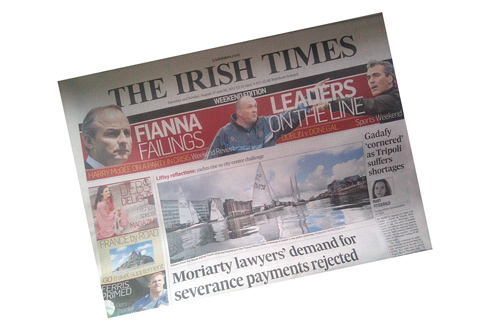
Although there was little wind for the confined event the class nevertheless made the headlines; splashed across the front page of this morning's Irish Times newspaper. An impressive five column wide photograph captioned 'Liffey reflections' by Irish Times snapper Brenda Fitzsimons is top of the page. One no doubt that will now hang on the wall of the Dun Laoghaire clubhouse!
Gorman and Doorly Lift Flying Fifteen Title on Home Waters
Dublin Bay racers David Gorman and Chris Doorly have been crowned Flying Fifteen national champions tonight at the National Yacht Club after a seven race series on home waters. The Dubliners hled off a strong challenge from Northern Ireland pairings Brian McKee and Ian Smyth and Roger Chamberlian and Ian Scannell, both from Strangford Lough. The results of the last race this afternoon decided the title. 26 competed. McKee and Smith took second and Chmberlain/Scannell were third.
With no wind and racing on Friday, the Championship got under way in Dublin Bay on Saturday. In testing conditions race officer Con Murphy and his team provided four races with a further three on Sunday ensuring a full schedule.
Some of the fleet will head for the worlds in Hayling Island, Hampshire in July with the local travelling circuit continuing in Dunmore East in August and Cushendall in September.
Cruising Association Holds First 2011 Meeting on Dublin Bay
Dinner will be served at 8pm at a reduced cost of only €20 per person, Drinks in the bar, wine available @ €18 per bottle.
The is rally open to all cruising sailors, and there will be a brief presentation of the Strangford Lough cruise in late July.
The Cruising Association AGM will be held in a private room from 1900 – 1930 for CAI members interested in attending.
Latest Cruising news
100 Boats Sailing in for July's Dun Laoghaire Regatta
Royal Cork's Anthony O'Leary, Afloat.ie's Sailor of the Year, is an early entry for July's Volvo Dun Laoghaire Regatta that has already attracted 100 entries, 50% of which are come from outside the Dublin Bay area.
The hope is O'Leary (who will be sailing Antix Beag) will be joined by a Crosshaven club mate Conor Phelan (sailing Jump), both are previous cruiser class winners in the 17-division championships that starts this year on July 7.
The biennial event, hosted by all four waterfront clubs, prides itself as Ireland's biggest sailing event. Seven nations and 32 yacht clubs are represented. So far 14 clubs are coming from England, two from Scotland, two from Wales, one from the Isle of Man and one from France.
The massive event that is expecting up to 500 entires is chaired this time by local sportsboat sailor Adam Winkelmann.
Dublin clubs have not been slow to enter early either. As expected Dun Laoghaire's own waterfront leads the way; The Royal Irish YC has 19, the National YC has 11, the Royal St George YC nine and the Dun Laoghaire Motor YC three entries.
An early entry discount is in operation for the next 28 days only. Enter here.Click this link for the latest Dun Laoghaire Regatta.
Join the Regatta on Afloat's facebook page here.
National Yacht Club Hosts Offshore Sailing Talk
Sailing offshore? The National Yacht Club is staging an 'Introduction to Offshore Racing' evening next Saturday 7th April 2011 at 19.30 and a line up of speakers inlcudes Maurice 'Prof' O’Connell on winning the 2009 Dun Laoghaire to Dingle Race. Mick Liddy on how to prepare for offshore sailing. Former National Yacht Club commodore Peter Ryan will give tips on ISORA racing in the Irish Sea.
Whether you are a Round Ireland expert or an offshore newbie the Dun Laoghaire club stresses it is an informal night but a 'unique one' both for offshore sailing fans and those who might be considering going offshore for the first time this season.
All the latest ISORA News
All the latest ICRA News
All the latest La Solitaire du Figaro News
All the latest Round Ireland News
Dun Laoghaire Set for Topper World Champs
The club is expecting a turnout of up to 300 sailors that will make it the biggest dinghy sailing event in the country this year. "We will have a large contingent from the UK and many sailors from far away – we have had interest from Korea, Japan and Hong Kong, for example". Says Margaret Margaret Kneafsey, Chairperson of the Organising Committee.
Carlow sailor Finn Lynch, 16, who is the reigning British and Irish champion finished third in the 2010 World Championships in Lake Como, Italy.
The event has its own website with details on accommodation and logistics and entries.


























